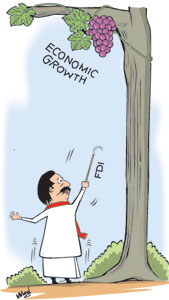High performance work systems for high performance companies
By Dushar Dayarathna-Senior Lecturer, Department of HRM, Faculty of Management Studies & Commerce, University of Sri Jayewardenepura/PhD candidate, La Trobe University, Australia View(s):Introduction
People are our most important asset and the human resource management (HRM) is an essential function in organizations that affects the quality of organizational performance (OP). Most of the high performance companies such as Apple, Toyota, General Electric (GE), Singapore Airlines (SIA) and Google have proved that management systems that encourage commitment and competence of people achieve greater productivity. Over the past few years, much of the debate about the contribution of HRM to OP has been wrapped up around the concept of high performance work systems (HPWS).
Definition and companion terminologies
The term HPWS can be defined as a system of HRM practices that increase the employees’ empowerment, knowledge, skills and incentives that ultimately motivate them to achieve greater performance. The term HPWS is a fuzzy notion and many companion terminologies have emerged such as best practices, best HRM practices, high commitment management, high involvement work systems, progressive human resource management, high investment work system, human capital enhancing HRM practices, flexible work systems or high commitment human resource practices.� Additional but not very popular terms used in the business world include socio-technical systems, work harmonization, quality of life programs, high performance management system, hybrid labour management model, innovative work systems, new work systems and alternative work systems.
Birth place of the concept
The concept of HPWS mainly focuses on employee involvement and organizational commitment and it has a long history dating back to the Human Relations and Tavistock Socio-Technical Schools, as well as the quality of working life movement of the 1970s. The HPWS concept first evolved in U.S. In the 1970s and 1980s, with the rise of Japanese ‘lean-production’ systems, US firms found that their HRM systems did not fit with their competitive context. To survive, US firms introduced HPWS to their workplaces. In addition to the above challenges, the advent of advanced manufacturing technology (AMT) and the rise of ‘offshoring’ to low-cost producers like China and India encouraged the application of HPWS to business organizations over the last 25 years. Most interestingly now the concept of HPWS is not limited to the field of HRM or strategic HRM but can be seen in the fields of labour economics, industrial or employment relations, organizational behavior, and operations management.
Core features of HPWS
The notion of HPWS has gained a widespread popularity and it is used not only by academics but also by government ministers, think-tanks, HR professional associations, trade unions, and management consultancies. If organizations are interested in implementing HPWS successfully for their organizations, the following characteristics need to be supportive.
- Self-managed teams and decentralization of decision making
- Selective hiring of new personnel
- Comparatively high compensation including performance and commitment incentives (e.g., financial incentives)
- Management planning and measurement (e.g., improved systems to measure employee performance)
- Extensive training
- More cooperative labour relations (e.g., a more consultative partnership style of labour relations with unions)
- Technology (e.g., better IT)
- Employment security
- Reduced status distinctions and barriers, including dress, language and office arrangements
HPWS generate positive outcomes for both individuals and organizations In recent years American- style HPWS have become the dominant global HRM system. Both researchers and practitioners report that the HPWS generate benefits to individual and organizational performances.
The application of HPWS helps to enhance trust in management and also organization’s capabilities. More specifically, HPWS are associated with lower employee turnover rates, higher employee satisfaction, higher employee commitment, higher labour productivity, lower injury rates and better safety performance, lower rate of burnout associated with emotional labour and better OP.
Applicability of HPWS for Sri Lankan organizations
HPWS are concerned with how HRM can be used to improve performance in manufacturing or service organizations with various kinds of employees. However, managers in Sri Lankan organizations need to customize HPWS to their specific industry and occupational conditions. HPWS are very productive when the employees have high task interdependence and counterproductive for employees who have low interdependence. HPWS are likely to be economic in high-tech, capital intensive manufacturing firms (e.g., steel making, clothing, electronic and automobile manufacturing industries) but unlikely to be economic in low-tech, labour-intensive industries (e.g. apparel and toy manufacturing industries). As stated above, HPWS are not simply a manufacturing issue. There is also evidence of HPWS practices being applied to service organizations.
For example professional services like banks and luxury hotels can improve revenue and customer retention through HPWS. But HPWS are unlikely to be economic in mass services where customers are price conscious and prefer to engage in self-service (e.g. fast food industry).
Although HPWS are an important concept in contemporary business world, there has been little discussion about how HPWS is understood, interpreted, and operationalized across the organizations in Sri Lanka. Therefore, there is a need to explore the impact of HPWS practices in Sri Lanka to understanding the relative effectiveness of HPWS in the Sri Lankan context.
(This article is a part of the author’s current research work on HPWS and for a list of references of all the reviewed articles, he could be reached at d.dayarathna@yahoo.com).��
comments powered by Disqus
















